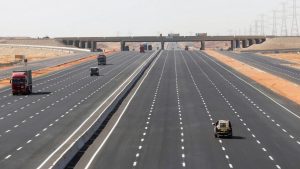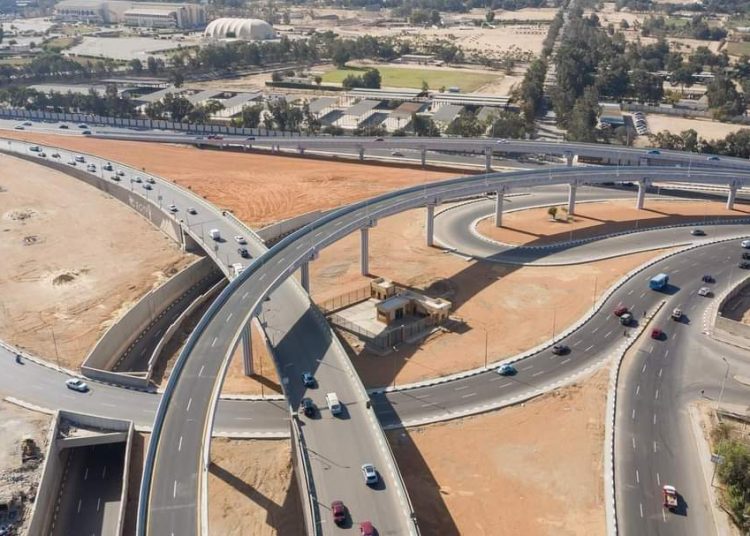Egypt’s growing population and dynamic economy have resulted in a need for greater infrastructure development over recent years. The Egyptian government has spearheaded significant investment in the road system to ensure that it will have the capacity to cope with long-term increases in population, freight and trade movement.
According to the World Bank, the Greater Cairo Metropolitan Area is home to around one-fifth of Egypt’s population — roughly 20.4 million people — a figure that is expected to rise to 24 million by 2027.
This sharp population increase will likely create additional pressure on road infrastructure in the capital. Despite lockdown during the Covid-19 pandemic, construction continued on Cairo’s new road projects. The projects are part of an $895 million government plan to reduce road congestion and build more than 40 new bridges.
Efforts for transport, logistics hub by 2024
Egypt will be transformed by 2024 into one of major global hubs for transport and logistics thanks to a massive 10-year plan to modernise its transport infrastructure, Minister of Transport Kamel el-Wazir said in recent remarks.
The 10-year plan, implemented from 2014 to 2024, was drawn up to modernise the transport and communication sectors, at an expected cost of around 1.7 trillion pounds.
The plan covers six main areas, including the roads and bridges, at a cost of LE474 billion, railways, LE225 billion, tunnels, LE837 billion, maritime transport, LE115 billion, dry ports and logistics, LE15 billion, and river transport, LE3 billion.
Huge suspension bridge over the Nile
One significant road project is the recently completed suspension bridge that crosses the Nile River at Warraq Island to the north of Cairo and forms part of a link stretching from the Red Sea to the northwest extremity of Egypt’s Mediterranean coast. It was inaugurated by President Abdel Fattah El Sisi in May 2019 and is the widest such bridge in the world.
Around one million cubic metres of concrete as well as 1,400 km (870 miles) of steel wire for 160 suspension cableswere used in its construction.
The bridge has six traffic lanes in each direction and measures 67.3 metres (222 feet) across. A regional director for the Guinness Book of World Records present at the opening said that makes it the world’s widest suspension bridge.
Cairo-Cape Town Road
The Ministry of Transport is seeking to complete the Cairo-Cape Town road shortly, with the road scheduled to be inaugurated in 2024.
The Ministry of Transport has made great strides in carrying out all works up to Arqin in Sudan with high quality.
The 10,228-kilometre (of which of which 1,155 kilometres will be in Egypt) Cairo-Cape Town road will pass through nine African countries.
The road will shorten travel time between north and south Africa to an average of only five days, fulfilling the dream to link Cairo and South Africa.
The Cairo-Cape Town road begins from the port of Alexandria on the Mediterranean Sea, passing through Cairo to Sudan, South Sudan, Ethiopia, Tanzania, Kenya, Zambia, and all the way to South Africa.
The road will pass through the governorates of Fayoum, Beni Sueif, Minya, Assiout, Sohag, Qena, Luxor and Aswan in Egypt.
The Ministry of Transport signed with the Sudanese Ministry of Transport in October 2020 a co-operation protocol in the field of railway linkage.
Funding of the project is through coordination and co-operation between Egypt, Sudan and the Kuwait Fund for Economic Development.
Cairo-Dakar Highway
The Cairo–Dakar Highway is trans-African highway 1 in the transcontinental road network being developed by the United Nations Economic Commission for Africa (UNECA), the African Development Bank (ADB), and the African Union. The major part of the highway between Tripoli and Nouakchott has been constructed under a project of the Arab Maghreb Union.
The Cairo–Dakar Highway has a length of 8,636 kilometres (5,366 miles) and runs along the Mediterranean coast of North Africa, continuing down the Atlantic coast of North-West Africa. It is substantially complete except for a few kilometres on the Western Sahara-Mauritania border where there is currently only a desert track.
Minister of Transport Kamel el-Wazir stressed that the regional and continental projects such as the Cairo-Cape Town Road, Egypt/Chad Road passing through Sudan, the railway line with Sudan, the navigational line between Lake Victoria and the Mediterranean Sea (VICMED) and the upgrade of Matrouh-Salloum railway will increase the volume of trade exchange between neighbouring countries.
The minister asserted the importance of the government and private sectors in partnership with foreign parties to implement strategic road projects along with partnership schemes between the Egyptian State and the private sector.
In recent remarks, Prime Minister Moustafa Madbouli said the state has attached great importance to road development and construction projects, especially those serving new cities and urban communities. Madbouli noted that road projects attract population, investment, and employment opportunities to new cities, in a way that serves the state’s vision towards achieving sustainable development.
For her part, Minister of Planning and Economic Development Hala el-Saeed has stressed the importance of the transport sector, which occupies special importance within the scope of the national projects adopted by the state to strengthen the foundations of the country’s infrastructure.
El-Saeed noted in recent press remarks that transportation networks represent the arteries of economic life, through which production centres and consumer markets are linked.
El-Saeed said that the transport sector occupies fundamental importance in the national economy due to Egypt’s privileged geographical location in the middle of international transport routes, and its proximity to major markets in Europe, Africa, and the Middle East, which makes it a global hub for transport, warehousing and logistics services.
Upper Egypt Western Desert Highway Development
At a length of 60 kilometres from Minya to Qusiya, the highway extends in six traffic lanes in each direction. They are divided into three traffic lanes for vehicles and three traffic lanes for trucks.The highway is one of the sectors of the Cairo-Cape Town Road connecting with Africa, in addition to tunneling works for the main intersections with the highway.
Sohag-Qena Western Desert Road Duplication
Two new lanes have been established for the current road, making the total number of lanes 4 (two lanes for each direction), with a length of 140 kilometres and a width of 10 metres.
The road will complement the duplication of El-Sa’id El-Sahrawy Western Road to reduce the rate of accidents and link the Delta to Upper Egypt’s governorates.

National Road Project
The National Roads Project is a large Egyptian infrastructure project initiated by President Abdel Fattah El Sisi in August 2014. The project includes the construction of 39 new roadways with a total length of 4,400 kilometres. The new road network will account for around 10 per cent of the total length of all roads in Egypt.
Ali Al-Biali, a professor of urban planning at Al-Azhar University in Cairo, said: “There can be no real development without an efficient road network.”
He told The Egyptian Mail that the state has been implementing the road projects to resolve traffic congestion, facilitate people’s daily movements, and reduce wasted time and fuel consumption.
“The National Road Project is aimed to relieve pressure on the Delta by constructing new desert roads that allow goods to be transported between the north and the south of the country,” he added, noting that the network links the eastern and western regions of Egypt through crosswise axes, which will allow development in the desert.
“The National Road Project will not only improve internal trade but also increase foreign trade and movement since it will link the domestic road network with international ones. Economic growth will be boosted,” Al-Biali said.

The Ministry of Housing, in conjunction with the New Urban Communities Authority, is constructing 14 ‘fourth-generation cities’, among which are the New Administrative Capital, New Alamein, New Mansoura, East Port Said, Nasser City in western Assiut, and New Ismailia.
According to Hassan el-Mahdi, a professor of transportation at Ain Shams University in Cairo, the state is currently building 32 new cities nationwide and also carrying out desert reclamation. “This would not have happened without the newly built road network,” el-Mahdi told this paper.
Regarding the development of roads in eastern Cairo, he said that the area is the capital’s gate to new urban communities like the New Administrative Capital, Al-Shorouk, and Badr City, and hence it was necessary to develop and expand the roads to link these new communities.






Discussion about this post